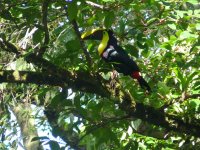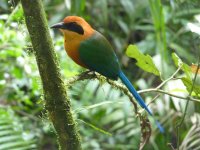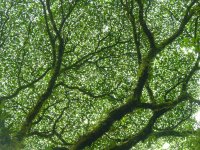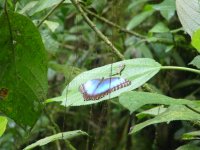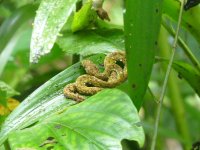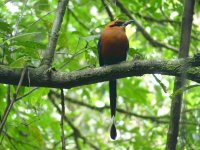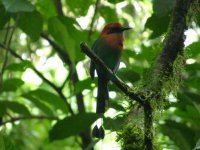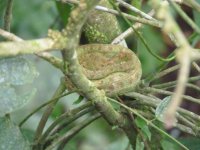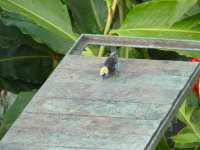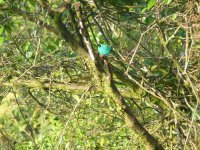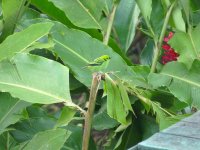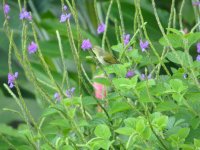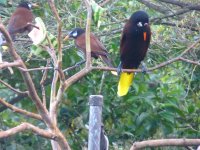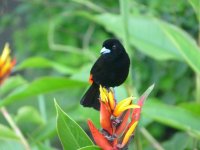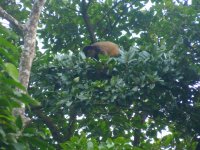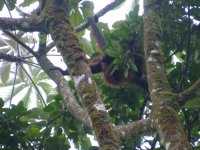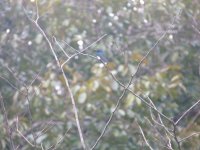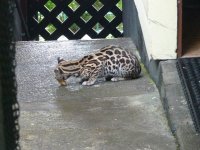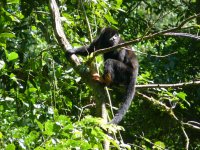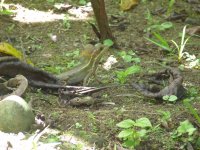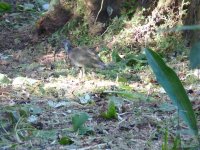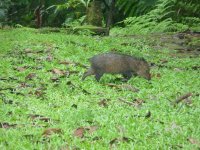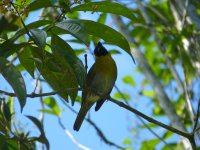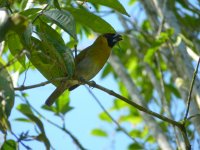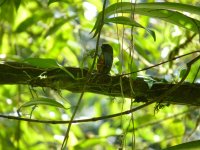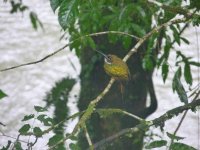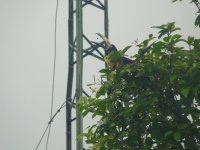Day 10, 6 January - Arenal National Park area
As anyone might imagine, we all enjoyed a terrific night's sleep at the luxurious Arenal Observatory Lodge. On this morning, some students elected to sleep in a bit (I don't blame them!). However, I couldn't keep myself inside when I remembered I was in the tropics.
Since I wasn't supposed to go on the trails alone, I relaxed a bit at the deck feeders watching the usual suspects before enjoying a sumptuous breakfast. We all got a tremendous treat when the clouds lifted from the volcano and its full grandeur showed for a while. It was even better when viewed from "The Nest", the observatory's 90m canopy tower! I enjoyed several new species on the walk to and from the tower, including White-collared Swift, Cinnamon Becard, Olive-backed Euphonia, Variable Seedeater, and a brief but exciting look at my only White-ruffed Manakin of the trip. We also had great views of a mixed flock of tanagers and two Yellow-throated Toucans in the fruit trees.
It was soon time to get in the bus for a day trip to the Arenal Misticopark hanging bridges. This is a spectacular location, with swaying bridges as high as 45m and as long as 90m! Of course, our guide was not a fantastic birder by ear, but she was quite talented at guiding and knew a good number of birds. Within minutes of starting our tour, I saw my lifer Black-headed Saltator, White-throated Thrush, and a pair of lively Buff-rumped Warblers. Farther along, the first of several Rufous Motmots reinforced my glowing impressions of the motmot family. Our guide pointed out a Giant Banded Anole, which sat surprisingly still on a large tree trunk. A new mammal was added when Marjana (our guide) found some Greater White-lined Bats roosting on another tree. I got yet another motmot, this one a Broad-billed Motmot. A persistent call led me to a small subject, but one that I couldn't pin down. By "eavesdropping" a bit on the next group's tour leader, I discovered it was a Scale-crested Pygmy-Tyrant! I did eventually get a better look, even glimpsing its little crest. We all got views of a sloth, but one that chose not to show its head. We were to have great sloth experiences later on at La Selva. Our expert "tarantulista" classmate found several fine specimens, including a white tarantula that I didn't see. Later, we saw a Tarantula Hawk Wasp Pepsis sp. dragging a tarantula along the railing! The guide said she had never seen one in action before.
Upon beginning the trek back, a pair of very quiet birds revealed themselves as the rather scarce Streak-crowned Antvireo. We headed down a hill and saw a gorgeous Blue Morpho sitting with its upper wings exposed. Immediately afterwards, the forest exploded with bird calls and all kinds of species flooded through the forest. I had hit a classic tropical mixed flock! Of course I was totally overwhelmed. I made the executive decision NOT to stress over assorted woodcreepers, which paid off in the end. One of the highlights was a Rufous-winged Tanager that I found, apparently uncommon and desired by tour groups. Other fine species included Carmiol's Tanager, White-shouldered Tanager, Tawny-capped Euphonia, Russet Antshrike, Bay Wren, Long-billed Hermit, White-throated Shrike-Tanager, and a few other common inhabitants. A major non-bird highlight occurred when the guide showed us not one, but two Eyelash Vipers below eye level. These were another hoped-for reptile, and they sure didn't disappoint!
One last surprise awaited us before a quiet end to the hike. As we went along at a steady pace, the guide stopped me and asked, "Sir, you're the one who likes birds, right? I'd like to show you something." A quick scope setup revealed a striking and beautiful pair of Crested Owls at a known roost! This came as a wonderful surprise to me. While I was enthralled with the owls, other classmates photographed a Rufous-tailed Jacamar (seen at La Selva) and a mystery passerine that will probably feature soon in the ID forum.
We had one final night at the Arenal Observatory Lodge before our final location, the Organization for Tropical Studies at La Selva.
PHOTOS: Yellow-throated Toucan, Rufous Motmot, yos tree (spectacular from a distance!), Blue Morpho butterfly, and Eyelash Viper.





